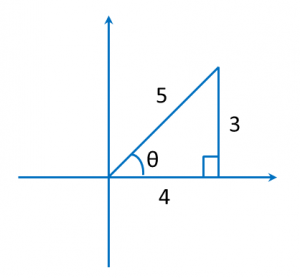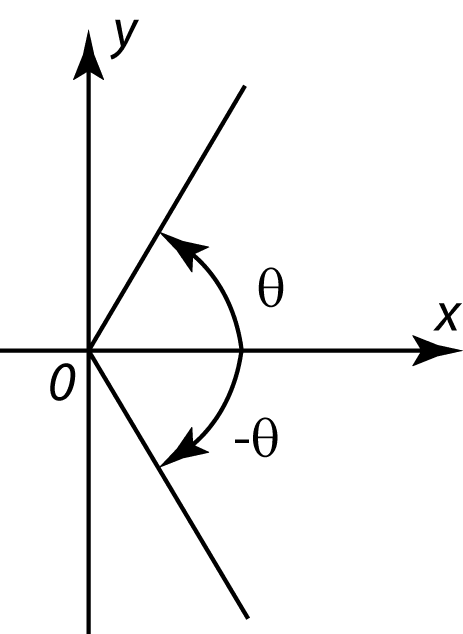(C) Solving Trigonometric Equation (Form Quadratic Equation in sinx/ cosx/ tanx/ cosecx/ secx/ cotx)
Example:
Find all the angles between 0° and 360° that satisfy each of the following equations.
(a) 3 sin² x – 2 sin x – 1 = 0
(b) 2 sin x = cosec x + 1
(c) 5 sin² x = 2 (1 + cos x)
(d) 2 sec x = 1 + cos x
(e) 2 cot² x + 8 = 7 cosec x
Solution:
(a)
3 sin² x – 2 sin x – 1 = 0
(3 sin x + 1)(sin x – 1) = 0
sin x = –⅓, sin x = 1
sin x = –⅓
basic angle = 19.47°
x = 180° + 19.47°, 360° – 19.47°
x = 199.47°, 340.53
sin x = 1, x = 90°
Hence x = 90°, 199.47°, 340.53°
(b)
2 sin x = cosec x + 1
2sinx=1sinx+1
(c)
5 sin² x = 2 (1 + cos x)
5 (1 – cos² x) = 2 + 2 cos x
5 – 5 cos² x – 2 – 2 cos x = 0
– 5 cos² x – 2 cos x + 3 = 0
5 cos² x + 2 cos x – 3 = 0
(5 cos x – 3)(cos x + 1) = 0
(d)
2 sec x = 1 + cos x
2cosx=1+cosx
(e)
2 cot² x + 8 = 7 cosec x
2 (cosec² x – 1) + 8 = 7 cosec x
2 cosec² x – 2 – 7 cosec x + 8 = 0
cosecx=32,cosecx=2sinx=23,sinx=12sinx=23basic angle =41.81∘x=41.81∘,180−41.81∘sinx=12basic angle = 30∘x=30∘,180−30∘Hencex=30∘,41.81∘,138.19∘,150∘
Example:
Find all the angles between 0° and 360° that satisfy each of the following equations.
(a) 3 sin² x – 2 sin x – 1 = 0
(b) 2 sin x = cosec x + 1
(c) 5 sin² x = 2 (1 + cos x)
(d) 2 sec x = 1 + cos x
(e) 2 cot² x + 8 = 7 cosec x
Solution:
(a)
3 sin² x – 2 sin x – 1 = 0
(3 sin x + 1)(sin x – 1) = 0
sin x = –⅓, sin x = 1
sin x = –⅓
basic angle = 19.47°
x = 180° + 19.47°, 360° – 19.47°
x = 199.47°, 340.53
sin x = 1, x = 90°
Hence x = 90°, 199.47°, 340.53°
(b)
2 sin x = cosec x + 1
2 sin ² x = 1 + sin x
2 sin ² x – sin x – 1 =0
(2 sin x + 1)(sin x – 1) = 0
sin x = –½, sin x = 1
sin x = –½
basic angle = 30°
x = 180° + 30°, 360° – 30°
x = 210°, 330°
sin x = 1, x = 90°
Hence x = 90°, 210°, 330°
2 sin ² x – sin x – 1 =0
(2 sin x + 1)(sin x – 1) = 0
sin x = –½, sin x = 1
sin x = –½
basic angle = 30°
x = 180° + 30°, 360° – 30°
x = 210°, 330°
sin x = 1, x = 90°
Hence x = 90°, 210°, 330°
(c)
5 sin² x = 2 (1 + cos x)
5 (1 – cos² x) = 2 + 2 cos x
5 – 5 cos² x – 2 – 2 cos x = 0
– 5 cos² x – 2 cos x + 3 = 0
5 cos² x + 2 cos x – 3 = 0
(5 cos x – 3)(cos x + 1) = 0
cosx=35,cosx=−1cosx=35
basic angle = 53.13°
x = 53.13°, 360° – 53.13°
x = 53.13°, 306.87°
cos x = – 1
x = 180°
Hence x = 53.13°, 180°, 306.87°
x = 53.13°, 360° – 53.13°
x = 53.13°, 306.87°
cos x = – 1
x = 180°
Hence x = 53.13°, 180°, 306.87°
(d)
2 sec x = 1 + cos x
2 = cos x + cos² x
cos² x + cos x – 2 = 0
(cos x – 1)(cos x + 2) = 0
cos x = 1
x = 0°, 360°
cos x = –2 (not accepted)
Hence x = 0°, 360°
(e)
2 cot² x + 8 = 7 cosec x
2 (cosec² x – 1) + 8 = 7 cosec x
2 cosec² x – 2 – 7 cosec x + 8 = 0
2 cosec2x – 7 cosec x + 6 = 0
(2 cosec x – 3)(cosec x – 2) = 0cosecx=32,cosecx=2sinx=23,sinx=12sinx=23basic angle =41.81∘x=41.81∘,180−41.81∘sinx=12basic angle = 30∘x=30∘,180−30∘Hencex=30∘,41.81∘,138.19∘,150∘












